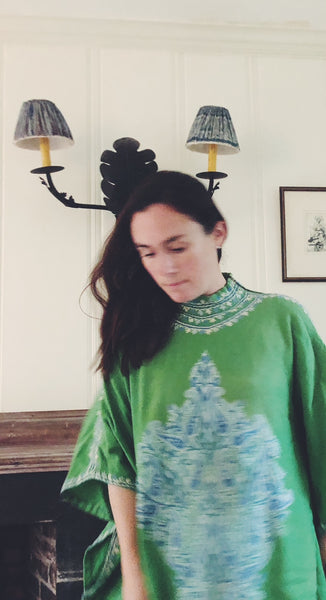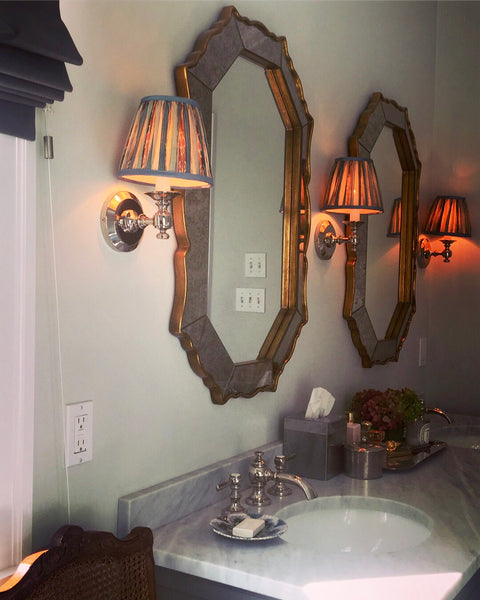
This week's Small Business that Inspires is Perrotine, a Massachusetts based handmade fabric lampshade company. The genesis of the company was founder's Lis Herbert love for vintage blockprints and textiles inspired by the Victoria and Albert Museum's collection of simple Indian calicos and elaborate, fanciful palampores. Each Perrotine shade is a work of art. And an instant room enhancer. Gray Antiques is thrilled to carry a selection of these lovely shades in our shop. See our current selection in our online shop or make an appointment to shop in person. Read on for more about Perrotine.....

Perrotine's founder and creative force, the chic Lis Herbert
What inspired you to create custom shades and when did you launch Perrotine?
For about 10 years I had a letterpress print shop, and while designing social stationery, I became fixated on designing patterns that would somehow imitate the feel of block-printed fabric, but on paper. I researched old textiles, studied interiors for pattern inspiration, and then one day it clicked that a love affair with these fabrics meant I should be working with them, not trying to reinvent them on paper. So I started buying silk and saris, not entirely sure what I would do with a growing collection, and then lampshades suddenly made perfect sense: good ones aren't easy to find, they can singularly transform a room, and I thought my eye for textiles might give me sure footing. I remember telling my dad I planned to do this in the members lounge at the Met, in a sea of white lampshades. Pay attention and you'll quickly realize that you are swimming in a sea of white lampshades.
Who are your mentors and what have they taught you?
I haven't really had mentors, at least not formally. I feel incredibly lucky to know John Ross and Don Carney of Patch NYC, two superlative gentlemen who are so kind in their criticism and generous in their encouragement. Looking much further back, It's maybe a bit of a stretch but in a sense I've had many accidental mentors. My early upbringing in New York City and our weekend house in Kent -- between my parents, my friends' parents and my parents' friends -- subconsciously defined my ideas about what works and what doesn't. They all taught me, surely without necessarily meaning to, how proportion, structure, color and pattern create a dialogue in architecture and interiors. Outside the city that meant rambling country houses and in New York that mostly meant apartments that would no doubt make my jaw drop if I revisited them today. I spent many afternoons at the Met, MoMA, and The Whitney, absorbing it all like a sponge. Ditto the Metropolitan Opera, where I spent many more hours than I wanted to at the time, but I am filled with gratitude for the experience now. Between the city, the country, the opera and the museums, I was saturated in beauty, and I remember all of it so vividly: what thrilled me then still thrills me today, After college I did a brief stint in architectural preservation, which cemented my preference for the old over the new. I can't point to mentors, but I can claim a first rate visual education.

Sconce shades in Gray Antiques' co owner Carol Vargo's master bath
What are your favorite aspects of running Perrotine? What are your least favorite?
I fall in love with just about every new lampshade as soon as I stitch the fabric to the frame. And it is especially exciting to take a handful of visual cues from a client and match them to the perfect silk from my inventory -- I don't need much to go on, and I love it so much when we figure it out on the first pass.
I don't love trimming the lampshades, which takes me about as much time as all other steps combined. And I don't know what to do with all of the odd fabric ends, which I don't want to toss. It isn't really a problem, but something I grumble about.
Lis' chic shades at Gray Antiques
How would you like to see your business grow in the next three years?
I would love to go back to designing patterns, many of which I could easily revisit from my letterpress days. I've flirted over the years with a line of textiles, but I am hyper sensitive to environmental sustainability and accountability, and I don't really want to be responsible for new, physical things. In practical terms, this means sorting out how to tread lightly on the earth. Quite the push and pull: how do you simultaneously maintain a light footprint and both satisfy the urge to create and also expand your client base? For me, I think this probably means printing on vintage cotton and linen, in small runs, and creating table linens or some other small-scale, limited run, useful but beautiful things.
Whom do you count among your style icons, whether it be in textiles, interiors, or fashion?
Only when I consider them all together do I realize that my style icons, at least for interiors and architecture, are all firmly American: Albert Hadley, Sister Parish, Bunny Mellon, Bruce Budd, David Netto, Jeffrey Bilhuber, Tom Scheerer and Gil Schafer. I'd happily live in any country house dreamed up by Daniel Romualdez. And I am desperate to see more of Kate Brodsky's house in East Hampton.
Do you have other passions beyond Perrotine?
I spend an enormous amount of time all day, on every day of the year, thinking about my gardens. Often I wish I could speed things up quite a bit -- especially in February, or after planting a slow-growing something -- but I am happiest in a meditative, quiet deep dive into the dirt. There is nothing better, especially in New England, than the moment you realize you've just heard birds for the first time since the fall, and that you can smell dirt again. I'd love to design gardens if this gig gets old.








Leave a comment